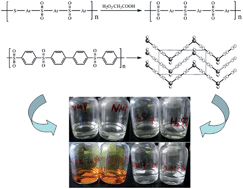Poly(arylene ether sulfone) containing thioether units: synthesis, oxidation and properties
Abstract
Two kinds of high glass temperature poly(arylene ether sulfone)s containing thioether and biphenyl units (PASSs) have been developed. The polymers were prepared by a polycondensation reaction of 4,4′-bis(4-chlorophenylsulfone)biphenyl (BCPSB) and 4,4′-dimercaptodiphenyl sulfone (DMDPS) (or 4,4′-bis(4-mercaptophenylsulfone)biphenyl (BMPSB)). They showed good thermal properties such as a relatively high glass transition temperature of 263–282 °C and a 5% weight-loss temperature (T5%) of 441–445 °C. The water flux and retention rate of the resultant membranes were 0.61–2.48 L m−2 h−1 and 89.47–94.91%, respectively. Interestingly, we found that the corrosion resistance of the membranes had been largely improved with the oxidization treatment. They were even insoluble in NMP, DMSO, concentrated H2SO4, aqua regia and so on, while the polymers without oxidation were soluble or destroyed in above solvents. In addition, we found the water flux of the oxidized membrane was also improved but the retention rate only decreased a little.


 Please wait while we load your content...
Please wait while we load your content...